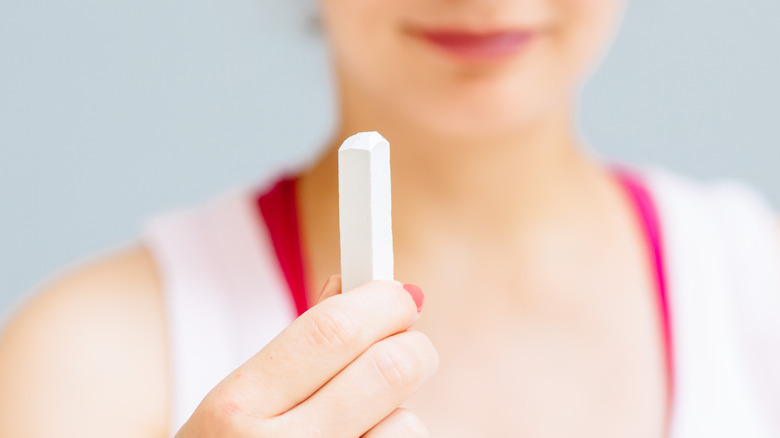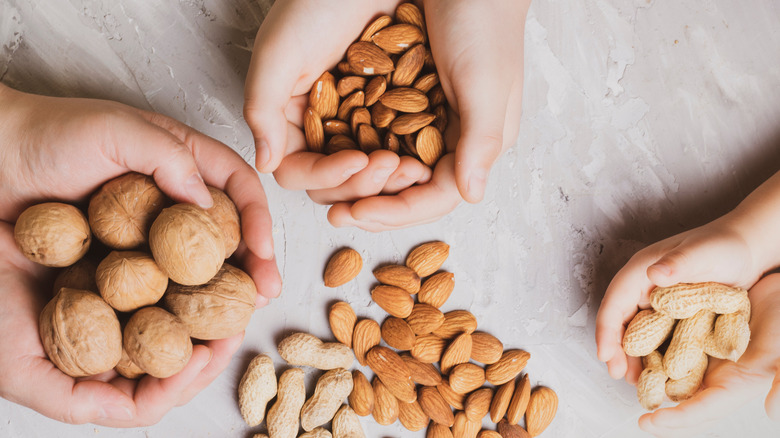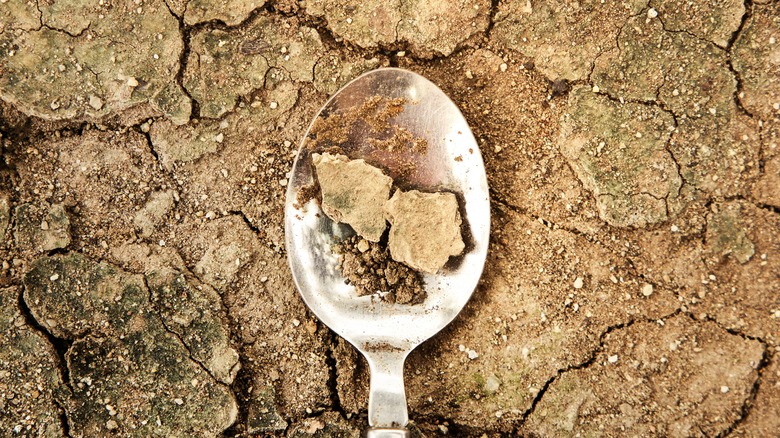What It Really Means When You Want To Eat Chalk
Eating chalk has garnered attention on social media in recent years, per Vox. Like many bizarre trends, videos of people chewing and crunching on pieces of chalk have gone viral, capturing audiences' attention globally. This is often seen in ASMR (autonomous sensory meridian response) videos, which are aimed at triggering a sensory response like a tingling sensation through the use of certain sounds.
But chalk-eating isn't just a way to get more views on Instagram and TikTok. For some people, the phenomenon signals an actual eating disorder that goes by the name of pica (via Epidemiology and Psychiatric Sciences). Individuals struggling with pica uncontrollably crave and consume non-food substances, which usually have no nutritional value. Some of the inedible things that people eat include clay, starch, ice, and chalk (via the International Journal of Homoeopathic Sciences). People can even yearn for potentially hazardous items like glass, metal, paint, and pebbles.
Although pica has affected people for centuries, it remains a somewhat mysterious illness (via Cureus). Scientists are yet to unravel its deeply complex etiology. Here are some things that we already know about pica and its possible causes.
The role of nutritional deficiencies
Some researchers believe that your peculiar predilection towards chalk may stem from a nutritional or mineral deficiency (via the International Journal of Homoeopathic Sciences). For instance, it's possible that you could have low levels of iron or zinc. A study published in the American Journal of Human Biology found that more than 6,000 participants linked their pica-like behaviors to depleted red blood cell count or levels of zinc in their bloodstream.
This theory might explain why pica symptoms are particularly common in pregnant women, affecting approximately 68% of moms-to-be in the U.S. It's been suggested that anemia during pregnancy is the main culprit behind unusual non-food cravings such as chalk. In some parts of the world, folklore leads women to believe that nonfood substances like chalk could be nutritionally beneficial for them, and that's why they crave it (via Nursing Open). But in reality, consumption of inedible items can often cause gastrointestinal issues and constipation, and can even exacerbate conditions like anemia.
Your mental health could be to blame
Some people feel like eating, biting, or crunching on things as a way to cope with their difficult emotions (via Cureus). In a few cases of pica, patients compulsively chew on ice when trying to deal with psychological stressors in their lives. Gnawing on chalk could be a similar coping mechanism, which is either consciously or covertly used to alleviate feelings of anxiety and discomfort.
There's evidence that pica can sometimes arise from past negative experiences and trauma (per Psychiatric Times). For instance, it's often seen in those who've experienced abuse, neglect, or other psychological stressors throughout their childhood. It's possible that when a child feels unsafe with little parental comfort and a sense of insecurity, they may turn to eating nonfood items as a solution to their care needs (via the Journal of Clinical Psychology in Medical Settings).
It's not uncommon for the condition to show up in those struggling with a mental health disorder like depression or obsessive-compulsive disorder (via Cureus). It's believed that this might be one of the reasons why pica is so prevalent among pregnant women, since many moms-to-be experience psychological problems such as stress, anxiety, or depressive symptoms (via Trends in Psychology). The most common form of pica observed during pregnancy is ice-eating, also known as pagophagia, and women generally report feeling of satisfied after their pica behaviors.
If you or someone you know needs help with mental health, please contact the Crisis Text Line by texting HOME to 741741, call the National Alliance on Mental Illness helpline at 1-800-950-NAMI (6264), or visit the National Institute of Mental Health website.
The link between pica and neurodevelopmental issues
The presence of a neurodevelopmental condition, like Autism Spectrum Disorder (ASD), is identified as another prominent risk factor for pica (via the Centers for Disease Control and Prevention). Among preschool-aged children with ASD, the prevalence of pica is estimated to be around 28% in those who also have a co-occurring intellectual disability (ID) and 14% in children without an ID.
People with autism often consume and display an appetite for strange substances like chalk, pebbles, and plastic objects, among other things, per the National Autistic Society. This might be due to issues around processing sensory information. For example, people with autism can be hypersensitive to sensory input, which means they're overreactive to certain textures or tastes, whereas others might be hypo-sensitive, namely underreactive. Both of these responses can lead to sensory-seeking behaviors, which may take the form of pica, particularly when an individual feels emotionally dysregulated. For some, the behavior might be soothing and comforting. Others may simply enjoy the way it feels to eat or chew on an inedible item like chalk.
Wanting to eat chalk could be the result of food insecurity
Some researchers have found that the prospect of food scarcity can lead to different forms of disordered eating, including pica behaviors (via the Journal of Agriculture and Food Research). Pica tends to be more prevalent in low income countries, after all, where people experience higher levels of food insecurity, food restriction, malnutrition, and hunger compared to other countries. The inaccessibility and unaffordability of nutrient-rich foods can have notably detrimental effects on individuals' physical, emotional, social and cognitive well-being.
In pregnant women, food insecurity increases the risk of various issues like obesity, diabetes, hypertension, stress, and fetal birth defects. It can also result in restrictive eating, which, alongside the various hormonal and physical changes that occur throughout pregnancy, can trigger pica. What's more, eating certain inedible substances may serve as an appetite suppressant or filler for people who don't have enough food to eat (via African Health Sciences). This is believed to be one of the reasons why the consumption of earth is sometimes observed in people with anorexia.
On the other hand, some studies indicate that the association between pica and high food insecurity is weak and needs further investigation to be understood (via the International Journal of Environmental Research and Public Health).
Is eating chalk dangerous?
Eating nonfood substances like chalk can be relatively harmless, especially if they're consumed in small amounts (via Nursing Open). However, the frequent consumption of inedible items can also lead to gastrointestinal problems, blocked intestines, micronutrient imbalances, transmission of parasites, and heavy metal poisoning (such as lead). On the severe end of the spectrum, pica could even result in death (via The American Journal of Forensic Medicine and Pathology).
Chalk is generally considered to be non-toxic, which is why it's safe for children to play with and even put into their mouths (in moderation), per Babygaga.
In a study published in the World Journal of Pharmaceutical Research, researchers found that eating calabash chalk –- a type of clay –- is a common practice in some parts of Africa, such as Nigeria. This habit often crops up among pregnant women, as it's believed to help curb their nausea. However, calabash chalk happens to contain both lead and arsenic, which are known to be harmful to the brain. These chemicals can cause cognitive dysfunction and decline if ingested in large quantities and for a prolonged period of time. The researchers discovered that eating calabash chalk can negatively impact health in a number of ways, causing gastrointestinal damage or anaemic effects. It can also affect the neuronal activities in the body, increasing the perception of pain and anxiety, which could be a symptom of lead and arsenic poisoning.
Is eating chalk accepted in some cultures?
Pica isn't always an eating disorder. In some parts of the world, the consumption of nonfood stuff is a culturally and socially accepted phenomenon (via African Health Sciences). For example, eating clay, earth, or soil -– medically termed as geophagia -– isn't unusual in certain parts of Africa, such as Tanzania, sub-Saharan Africa, and the Transkei region of South Africa. Geophagia was also once documented in ancient Greek and Roman textbooks, and has been reported in some southern parts of the United States.
Eating chalk, in particular, may be a feature of religious ceremonial rituals in some communities (via Social Work in Public Health). According to a study of pica on Mfangano Island in Kenya, around 25.6% of women reported eating a chalky, rock-like material called odowa (via the International Journal of Environmental Research and Public Health).
The ingestion of kaolin, known as white dirt, white clay, or chalk, has also been widely documented by physicians in a rural part of Georgia, namely the central Piedmont region (via the Southern Medical Journal). Little is known about where this behavior stems from, but based on anecdotal reports, some people in Georgia eat chalk simply because they appreciate the taste (via the New Georgia Encyclopedia). It's often dug out directly from the earth, but it can also be bought from certain stores, where it's sometimes packaged in the form of fresh produce. However, their labels tend to read: "Not suggested for human consumption."
How is pica diagnosed?
The diagnosis for pica is made from a clinical history of the individual, per the National Eating Disorders Association. The assessment may also involve tests for anemia, toxicity, and other side effects of ingesting nonfood substances. This might include chalk, cloth, soap, paper, baby powder, and eggshells, to name a few (via StatPearls Publishing).
According to the fifth edition of the Diagnostic and Statistical Manual of Mental Disorders (DSM-5), symptoms must have been occurring for at least a month in order for a diagnosis of pica to be made, and these shouldn't be part of a socially or culturally accepted practice (via StatPearls Publishing). Children under the age of two generally wouldn't receive a diagnosis of pica, since eating and chewing forgeign objects is often considered to be a normal part of infant development.
Often, pica isn't diagnosed until it starts to cause serious medical problems like infections or damaged teeth, notes Beat –- an eating disorders charity based in the UK. The condition can affect individuals' lives for many years, particularly those with mental health and intellectual problems, and it can even lead to serious health consequences if it isn't treated (via StatPearls Publishing).
How is pica treated?
If blood tests indicate that a nutritional deficiency might be at the root of your behaviors, your doctor may offer nutritional treatment, according to the National Eating Disorders Association. This may include supplements or a specific diet plan to correct your nutritional imbalances.
A study published in the Journal of Autism and Developmental Disorders found that an intensive behavioral intervention can be effective at treating pica in children with intellectual and developmental disabilities. The interventions differed slightly for different individuals, but generally included physically stopping the child from eating nonfood objects by shadowing and restraining them, redirecting them to an alternative activity, and rewarding them from getting rid of the inappropriate object rather than eating it. The findings showed that the pica behavior diminished and disappeared over time.
If chalk-eating is closely tied to another mental health problem like obsessive-compulsive disorder, you may be prescribed medication (via CNS Spectrums). There are no specific drugs for pica, but antipsychotic drugs like Olanzapine have been shown to dampen cravings and reduce impulses and urges. Success rates for pica interventions tend to vary (via StatPearls Publishing). The disorder can sometimes go away on its own, such as in pregnant women and children, but it can also linger for many years. Early detection can help individuals receive timely intervention to manage their disorder. If you've been craving or eating nonfood items, reach out to your doctor to chat about your symptoms and explore what support might be available to you.









